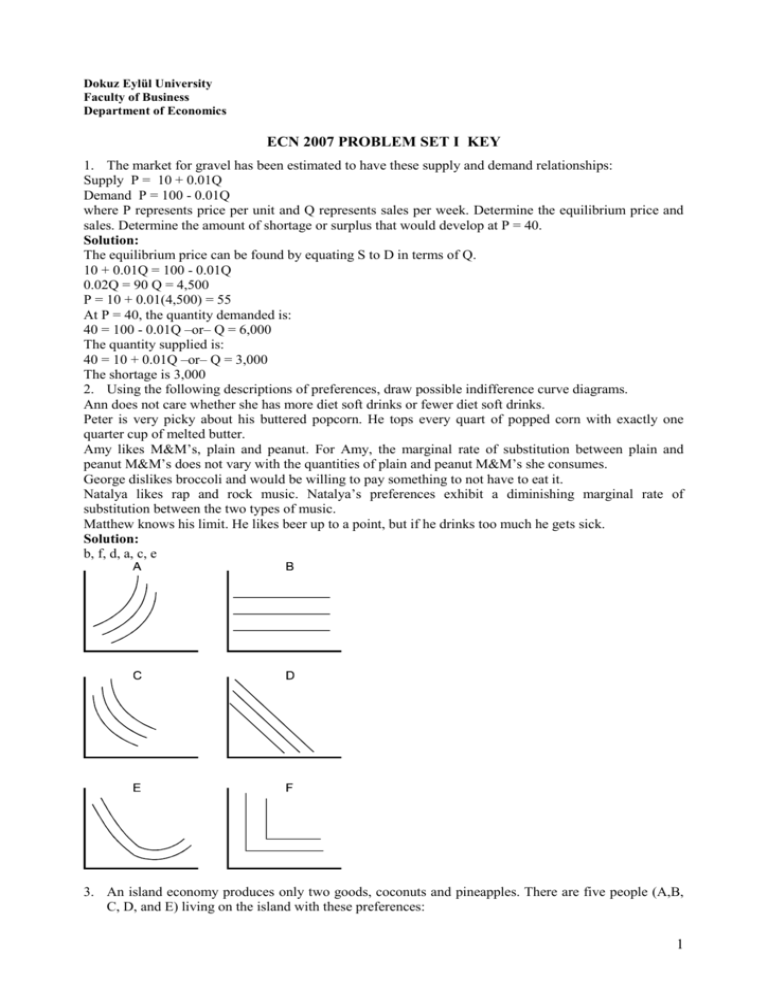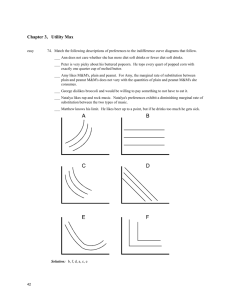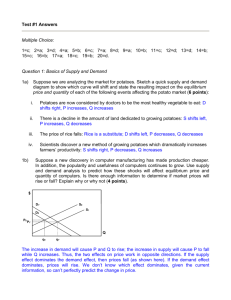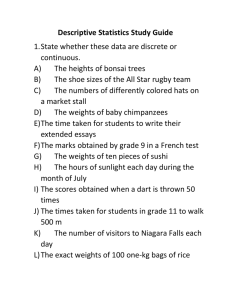ECN 2007 Problem Set 1 Key: Economics Solutions
advertisement

Dokuz Eylül University Faculty of Business Department of Economics ECN 2007 PROBLEM SET I KEY 1. The market for gravel has been estimated to have these supply and demand relationships: Supply P = 10 + 0.01Q Demand P = 100 - 0.01Q where P represents price per unit and Q represents sales per week. Determine the equilibrium price and sales. Determine the amount of shortage or surplus that would develop at P = 40. Solution: The equilibrium price can be found by equating S to D in terms of Q. 10 + 0.01Q = 100 - 0.01Q 0.02Q = 90 Q = 4,500 P = 10 + 0.01(4,500) = 55 At P = 40, the quantity demanded is: 40 = 100 - 0.01Q –or– Q = 6,000 The quantity supplied is: 40 = 10 + 0.01Q –or– Q = 3,000 The shortage is 3,000 2. Using the following descriptions of preferences, draw possible indifference curve diagrams. Ann does not care whether she has more diet soft drinks or fewer diet soft drinks. Peter is very picky about his buttered popcorn. He tops every quart of popped corn with exactly one quarter cup of melted butter. Amy likes M&M’s, plain and peanut. For Amy, the marginal rate of substitution between plain and peanut M&M’s does not vary with the quantities of plain and peanut M&M’s she consumes. George dislikes broccoli and would be willing to pay something to not have to eat it. Natalya likes rap and rock music. Natalya’s preferences exhibit a diminishing marginal rate of substitution between the two types of music. Matthew knows his limit. He likes beer up to a point, but if he drinks too much he gets sick. Solution: b, f, d, a, c, e 3. An island economy produces only two goods, coconuts and pineapples. There are five people (A,B, C, D, and E) living on the island with these preferences: 1 A has a strong preference for pineapples. B has a strong preference for coconuts. C doesn’t care for pineapples (assigns no value to them). D doesn’t care for coconuts (assigns no value to them) E will only consume pineapples and coconuts in the fixed proportion of one pineapple to one coconut. For each of these five individuals, construct a representative indifference curve with pineapples on the vertical axis and coconuts on the horizontal axis. Discuss the shape of the indifference curves and relate them to the MRS. Solution: Individual A has relatively flat indifference curves, since A requires relatively large numbers of coconuts to compensate for the loss of pineapples that she values highly. Individual B has relatively steep indifference curves, since B requires relatively few coconuts to compensate for the loss of pineapples that he does not value highly. C’s indifference curves are vertical; the level of satisfaction is affected only by coconuts. D’s indifference curves are horizontal; the level of satisfaction is affected only by pineapples. E’s indifference curves are L-shaped. MRS measures (at the margin) the maximum number of pineapples that the consumer will be willing to give up in order to get one more unit of coconuts. A’s MRS is low. A is willing to relinquish few pineapples relative to coconuts since pineapples are dear to A. B’s MRS is high, for the opposite reason. C’s MRS is infinite. Since C’s utility is not affected by pineapples, she is willing to relinquish all pineapples (an infinite number) to obtain additional coconuts. D’s MRS is zero. D is not willing to give up any pineapples to obtain additional coconuts. E’s MRS is infinite when Qp> Qc, zero when Qc > Qp, and undefined when Qc = Qp. 4. Ali is a college student who has 500 TL of income to spend each semester on books and pizzas. The price of a pizza is 10 TL and the price of a book is 50 TL. Diagram Ali’s budget constraint. Now, suppose Ali’s parents buy him a 300 TL gift certificate each semester that can only be used to buy books. Diagram Ali’s budget constraint when he has the gift certificate in addition to his 500 TL income. Is Ali better-off with the gift certificates? Solution: Without the gift certificate, Ali’s budget constraint is indicated by the line segment from 10 books and 0 pizza to 0 books and 50 pizzas (labeled BC1). With the gift certificate that can only be used for book 2 purchases, Ali still cannot afford anymore than 50 pizzas. However, he is guaranteed 6 books even if he spends all his money on pizza. Since the price of books and pizza hasn’t changed, the slope of his new budget constraint is the same as the slope of the old budget constraint. The new budget constraint is drawn above as BC2. Note that with the gift certificate, Ali has an expanded opportunity set and is guaranteed more of both goods no matter what his original consumption choice on BC1 was. This implies that Ali is strictly better-off with the gift certificate. 5. A vegetable fiber is traded in a competitive world market, and the world price is $9 per pound. Unlimited quantities are available for import into the United States at this price. The U.S. domestic supply and demand for various price levels are shown below. What is the equation for demand? What is the equation for supply? Price U.S. Supply U.S. Demand 3 2 34 6 4 28 9 6 22 12 8 16 15 10 10 18 12 4 Solution: The equation for demand is of the form Q=a-bP. First find the slope, which is Q 6 2 b. P 3 Demand is now Q=a-2P. To find a, plug in any of the price quantity demanded points from the table: Q=34=a-2*3 so that a=40 and demand is Q=40-2P. The equation for supply is of the form Q = c + dP. First find the slope, which is Q 2 d. Supply is P 3 2 P. To find c plug in any of the price quantity supplied points from the table: 3 2 2 Q 2 c (3) so that c=0 and supply is Q P. 3 3 now Q c 6. Draw indifference curves that represent the following individuals’ preferences for hamburgers and soft drinks. Indicate the direction in which the individuals’ satisfaction (or utility) is increasing. a. Joe has convex preferences and dislikes both hamburgers and soft drinks. b. Jane loves hamburgers and dislikes soft drinks. If she is served a soft drink, she will pour it down the drain rather than drink it. c. Bob loves hamburgers and dislikes soft drinks. If he is served a soft drink, he will drink it to be polite. d. Molly loves hamburgers and soft drinks, but insists on consuming exactly one soft drink for every two hamburgers that she eats. e. Bill likes hamburgers, but neither likes nor dislikes soft drinks. f. Mary always gets twice as much satisfaction from an extra hamburger as she does from an extra soft drink. Solution: A 3 hamburger soft drink B hamburger soft drink C hamburger soft drink D hamburger soft drink E hamburger soft drink F 4 hamburger soft drink 7. The price of DVDs (D) is 20 TL and the price of CDs (C) is 10 TL. Ahmet has a budget of 100 TL to spend on the two goods. Suppose that he has already bought one DVD and one CD. In addition there are 3 more DVDs and 5 more CDs that he would really like to buy. Given the above prices and income, draw his budget line on a graph with CDs on the horizontal axis. What happens to the budget line when his income increases to 160 TL? What happens to the budget line when the price of CDs decreases to 5 TL? 8. A consumer decides not to buy a MP3 Player when her income is 2000 TL. However, when her income rises to 3000 TL, she decides to buy one. In a single diagram, draw the budget lines and indifference curves to illustrate this situation (assume the MP3 Player costs 400 TL in both time periods). Be sure to label your diagram completely. Solution: At the lower budget constraint, the consumer is at a corner solution. That is, she purchases no MP3 players. The consumer has sufficient income to afford a MP3 player. However, given her preferences it is optimal to exhaust her budget on other goods. With her increase in income, the budget constraint shifts out. The consumer now has expanded consumption opportunities. In this case, the consumer chooses to purchase a MP3 player given the higher budget constraint. Purchasing one MP3 player is optimal as the indifference curve is just tangent to the budget constraint at the consumption bundle consisting of 1 MP3 player. 9. Üretken Enterprise has developed a new product called C’mon. The market demand and supply for this product is given as Q = 240 - 4P and Q=40+P, respectively. a) What is the equilibrium price and quantity for this product? b) If the government imposed per unit tax of 10 TL per C’mon manufactured, what would be the new equilibrium price of C’mon? Would a per unit tax on C’mon change the revenue received by Üretken Enterprise? Solution: a) Q = 240 - 4P and Q=40+P equilibrium price and quantity 240 - 4P=40+P P=40 Q=80 b) The tax represents a price increase to the purchaser regardless of the current price Thus, the supply curve will be adjusted vertically upward by 10 Q=40+P P= Q-40 New P=q-40+10 P=Q-30 Q=P+30 Equilibrium price P+30=240-4P P=22 Q=52 As quantity sold has fallen too, revenues would fall 5 10. Suppose the demand for widgets is given by QD=100-5p-pd+2I, where I is average consumer income, p is the price of lemons, and pd is the price of doodads. According to this equation, discuss whether widgets are an inferior good or not. Solution: Not inferior, as income increases, because of the positive coefficient (+2) for income, demand will increase. This indicates widgets are normal. 11. Suppose the market for grass seed can be expressed as: Demand: QD = 100 - 2p Supply: QS = 3p a. If government imposes a 5 TL specific tax to be collected from sellers, what is the price consumers will pay? How much tax revenue is collected? What fraction is paid by sellers? b. If government imposes a 10% ad valorem tax to be collected from sellers, what is the price consumers will pay? How much tax revenue is collected? Solution: a. At equilibrium without the tax, p = 20 and Q = 60. Rearranging the supply curve yields p = Q/3; adding the tax yields p = (Q/3) + 5. Substituting this into the demand curve yields Q = 100 - 2[(Q/3) + 5] = 90 - (2/3)Q or (5/3)Q = 90. Solving yields Q = 54 p = 23. Tax revenue = 5*54 = 270. Since price rose 3 on a 5 tax, consumers pay 3/5 of the tax or 162, and sellers pay 2/5 of the tax. b. First rearrange the supply curve, p = Q/3. Sellers must receive this price plus 10% more to pay the tax. Thus p + tax = (1.1Q)/3. Substituting into the demand curve yields Q = 100 - (2.2/3)Q or (5.2/3)Q = 100 or Q = 57.69. Solving for price plus tax yields p + tax = (100 - 57.69)/2 = 21.15. Solving for the price yields p = 21.15/1.1 = 19.23. Tax revenue equals (21.15 - 19.23) * 57.69. 12. Canan views pizzas and burritos as goods. If she prefers a bundle of four burritos and four pizzas to a bundle of four burritos and five pizzas, which property of consumer preference is violated? What change in the assumptions could lead a rational consumer to prefer the first bundle? Solution: The property of more-is-better is violated. However, if pizza is a bad, then a rational consumer would prefer the first bundle. 13. Canan has an income of 100 TL. She spends all of her income on pizza and burritos. A pizza costs 10 TL and a burrito costs 5 TL. However, the store where Canan buys her burritos has a special deal. After you’ve bought six burritos, then you can buy each burrito for 2.50 TL. Draw Canan’s opportunity set. 6








